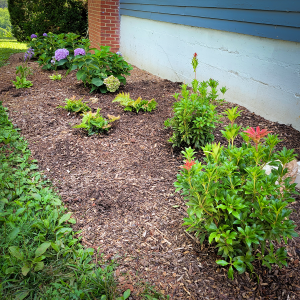We all know that some plants thrive in the hot sun and others prefer shadier spots, but what about those places around your house that are a little bit of both depending on the time of day? This is what we mean by a transitional bed – a space that gets sun in the morning but is shaded in the afternoon, or vice versa. These spaces can be tricky. [Read more…]
Putting your House on the Market? The Importance of a Pre-Listing Cleanup
When you’re preparing to put your home on the market, the ‘to-do’ list can be daunting. While you’re busy clearing out clutter and scheduling the photographer, don’t forget about the outside of your home. The pre-listing cleanup is an expense that will pay for itself many times over. [Read more…]
Protecting Your Shrubs with Oil
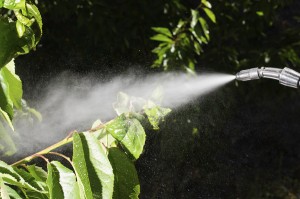 During dreary winter days I envy a plant’s ability to go dormant. I’ve considered putting a sign on my office door stating, “Dormant – do not disturb until spring”.
During dreary winter days I envy a plant’s ability to go dormant. I’ve considered putting a sign on my office door stating, “Dormant – do not disturb until spring”.
This time of year it is often recommended to spray “dormant oil” to control insects on everything from fruit trees to lilacs. But is it just any oil sprayed when the plants are dormant? Some commercial dormant oil sprays are refined from petroleum oil. But Dos Amigos Landscaping uses an eco-friendly horticulture oil made from Cottonseed Oil. Unlike home remedies, commercial spray oils have an emulsifier added to allow the oil to mix with water, so they won’t be damaged by rain.
Applying “Dormant Oils” kills exposed insects and mites by either suffocating them (covering up breathing tubes) or by directly penetrating the outside cuticle and destroying internal cells. Spraying dormant oil after bud break and leaves have emerged will still control the pests, but it may kill the young leaves or cause leaf edges to turn black if the correct oil is not used at the proper rate. So it is best to apply these oils in the dormant season—here in Virginia that means between February 1st to March 15th, with variability for the specific weather pattern of any particular year.
The cost of applying the Dormant Oils is generally nominal—you don’t have to spend a lot, to protect the high value of landscaped trees and shrubs.
Dr. Phil Nixon and Dr. Raymond Cloyd of the University of Illinois outlined the benefits of making an application of dormant oil.
Advantages include:
(1) a wide range of activity against most species of mites and scales, including some activity on eggs;
(2) minimal likelihood of insects’ or mites’ developing resistance;
(3) generally less harmful to beneficial insects and mites than other pesticides
(4) relatively safe to birds, humans, and other mammals.
Disadvantages of using dormant oil are:
(1) potential plant damage if incorrect oil is used or used at improper rate during the growing season and
(2) minimal residual activity to kill new pest infestations.
Dormant Oils are a great alternative to chemical pesticides. These oils don’t increase pesticide resistance because their mode of action is mechanical, not chemical.
Dos Amigos Landscaping can apply “Dormant Oil” to your important landscaping shrubs. Holly, Boxwood and Azaleas often benefit from this treatment. We have the equipment to spray upwards from underneath the plant, which makes it more effective since many of the pests hide on the underside of the foliage. The homeowner does not have to do a thing. Just contact us, and we will stop by your property to inspect and assess your landscaping plants. We will provide a proposal, including any remedies for other issues we may have identified when inspecting your valuable landscape trees and shrubs. And then schedule the treatment at the optimum time.
Contact Daniel Martin at Dos Amigos Landscaping today to begin the inspection process—or call: 434-465-0075.
Source material: Sandra Mason, Extension Educator, Horticulture, University of Illinois
Pruning shrubs and hedges
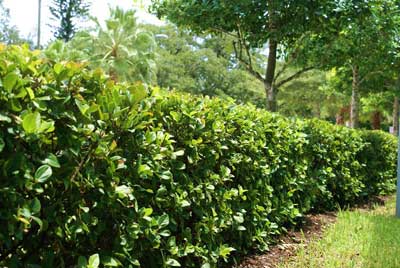 After the initial pruning at planting, hedges need to be pruned often. Once the hedge reaches the desired height, prune new growth back whenever it grows another 6 to 8 inches. Prune to within 2 inches of the last pruning. Hedges may be pruned twice a year, in spring and again in mid-summer, to keep them dense and attractive. Prune hedges so they’re wider at the base than at the top, to allow all parts to receive sunlight and prevent legginess.
After the initial pruning at planting, hedges need to be pruned often. Once the hedge reaches the desired height, prune new growth back whenever it grows another 6 to 8 inches. Prune to within 2 inches of the last pruning. Hedges may be pruned twice a year, in spring and again in mid-summer, to keep them dense and attractive. Prune hedges so they’re wider at the base than at the top, to allow all parts to receive sunlight and prevent legginess.
Renewal pruning for older or overgrown shrubs
Every year remove up to one-third of the oldest, thickest stems or trunks, taking them right down to the ground. This will encourage the growth of new stems from the roots. Once there are no longer any thick, overgrown trunks left, switch to standard pruning as needed.
Rejuvenation pruning for older or overgrown shrubs
Deciduous shrubs that have multiple stems (aka, cane-growth habit), and that have become very overgrown or neglected can be rejuvenated by cutting all canes back as close to the ground as possible in early spring. That season’s flowers may be sacrificed but the 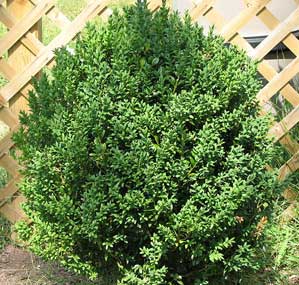 benefits from bringing the plants back to their normal size and shape outweigh this temporary “collateral damage.” This pruning technique works best for shrubs such as overgrown spirea, forsythia, cane-growth viburnums, honeysuckle and any other multiple stemmed shrubs that are otherwise healthy. Within one growing season, these shrubs will look like new plantings, full and natural shaped.
benefits from bringing the plants back to their normal size and shape outweigh this temporary “collateral damage.” This pruning technique works best for shrubs such as overgrown spirea, forsythia, cane-growth viburnums, honeysuckle and any other multiple stemmed shrubs that are otherwise healthy. Within one growing season, these shrubs will look like new plantings, full and natural shaped.
Pruning evergreens
With few exceptions, evergreens (conifers) require little pruning. Different types of evergreens should be pruned according to their varied growth habits.
- Spruces, firs and douglas-firs don’t grow continuously, but can be pruned any time because they have lateral (side) buds that will sprout if the terminal (tip) buds are removed. It’s probably best to prune them in late winter, before growth begins. Some spring pruning, however, is not harmful.
- Pines only put on a single flush of tip growth each spring and then stop growing. Prune before these “candles” of new needles become mature. Pines do not have lateral buds, so removing terminal buds will take away new growing points for that branch. Eventually, this will leave dead stubs. Pines seldom need pruning, but if you want to promote more dense growth, remove up to two-thirds of the length of newly expanded candles. Don’t prune further back than the current year’s growth.
- Arborvitae, junipers, yews, and hemlocks grow continuously throughout the growing season. They can be pruned any time through the middle of summer. Even though these plants will tolerate heavy shearing, their natural form is usually most desirable, so prune only to correct growth defects.
To learn more about the best time to prune shrubs download the Shrub Pruning Calendar courtesy of the Virginia Cooperative Extension. (pdf)
At Dos Amigos Landscaping we have the expertise to prune your trees and shrubs properly for maximum health and beauty of your trees, shrubs and landscaping. Right now (January to March) is the best time to prune most deciduous trees in Virginia. Contact us today we’ll come to your property, make an assessment and give you an estimate for pruning. Call Daniel Martin at 434-465-0075 to schedule an appointment or send an email.
It’s Pruning Time
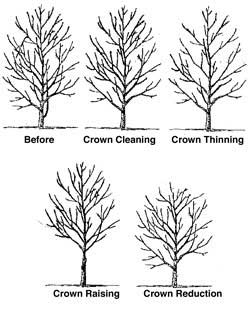
Pruning is a horticultural practice that alters the form and growth of a plant. Based on aesthetics and science, pruning can also be considered preventive maintenance. Many problems may be prevented by pruning correctly during formative years for a tree or shrub. It’s good to prune to promote plant health, remove dead branches or branches that are rubbing together. Pruning can also encourage flower and fruit development, and encourage hedge growth.
Timing is Everything!
The late dormant season is best for most pruning. Pruning in late winter, just before spring growth starts, leaves fresh wounds exposed for only a short length of time before new growth begins the wound sealing process. Another advantage of dormant pruning is that it’s easier to make pruning decisions without leaves obscuring plant branch structure. Pruning at the proper time can avoid certain disease and physiological problems:
Pruning at the proper time can avoid certain disease and physiological problems:
• To avoid oak wilt disease DO NOT prune oaks from April to October. If oaks are wounded or must be pruned during these months, apply wound dressing or latex paint to mask the odor of freshly cut wood so the beetles that spread oak wilt will not be attracted to the trees.
• To avoid increased likelihood of stem cankers, prune honey locusts when they are still dormant in late winter. If they must be pruned in summer, avoid rainy or humid weather conditions.
• Prune apple trees, including flowering crabapples, mountain ash, hawthorns and shrub cotoneasters in late winter (February-early April). Spring or summer pruning increases chances for infection and spread of the bacterial disease fireblight. Autumn or early winter pruning is more likely to result in drying and die-back at pruning sites.
• Some trees have free-flowing sap that “bleeds” after late winter or early spring pruning. Though this bleeding causes little harm, it may still be a source of concern. To prevent bleeding, you could prune the following trees after their leaves are fully expanded in late spring or early summer. Never remove more than 1/4 of the live foliage. Examples include:
— All maples, including box elder
— Butternut and walnut
— Birch and its relatives, ironwood and blue beech
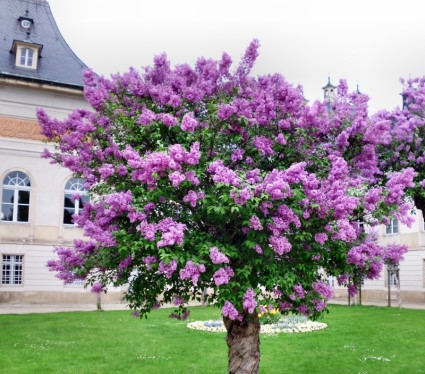 Prune before or after blooming?
Prune before or after blooming?
Trees and shrubs that bloom early in the growing season on last year’s growth should be pruned immediately after they finish blooming:
• apricot
• azalea
• chokeberry
•
chokecherry
• clove currant
• flowering plum
or cherry
• forsythia
• Juneberry
• lilac
• magnolia
• early blooming spirea
Shrubs grown primarily for their foliage rather than showy flowers should be pruned in spring, before growth begins:
alpine currant
barberry
buffalo berry
burning bush
dogwood
honeysuckle
ninebark
pea shrub
purpleleaf
sandcherry
smokebush
sumac
Shrubs that bloom on new growth may be pruned in spring before growth begins. Plants with marginally hardy stems such as clematis and shrub roses should be pruned back to live wood. Hardier shrubs such as late blooming spireas and smooth (snowball) hydrangeas should be pruned to the first pair of buds above the ground. To learn more about the best time to prune shrubs download the Shrub Pruning Calendar (PDF)
(Courtesy of the Virginia Cooperative Extension).
At Dos Amigos Landscaping we have the expertise to prune your trees and shrubs properly for maximum health and beauty of your trees, shrubs and landscaping. Right now (January to March) is the best time to prune most deciduous trees in Virginia. Contact us today we’ll come to your property, make an assessment and give you an estimate for pruning. Call Daniel Martin at 434-465-0075 to schedule an appointment or send an email.


